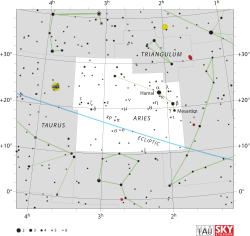娄宿三
| 觀測資料 曆元 J2000.0 | |
|---|---|
| 星座 | 白羊座 |
| 星官 | |
| 赤經 | 02h 07m 10.40570s[2] |
| 赤緯 | +23° 27′ 44.7032″[2] |
| 視星等(V) | 2.00[3] |
| 特性 | |
| 光谱分类 | K2-IIICa-1 |
| U−B 色指数 | +1.13[3] |
| B−V 色指数 | +1.15[3] |
| V−R 色指数 | +0.7[4] |
| R−I 色指数 | +0.62[5] |
| 变星类型 | Suspected[6] |
| 天体测定 | |
| 徑向速度 (Rv) | −14.2 ± 0.9[7] km/s |
| 自行 (μ) | 赤经:+188.55[2] mas/yr 赤纬:−148.08[2] mas/yr |
| 视差 (π) | 49.56 ± 0.25[2] mas |
| 距离 | 65.8 ± 0.3 ly (20.2 ± 0.1 pc) |
| 绝对星等 (MV) | +0.47 ± 0.04[8] |
| 詳細資料 | |
| 質量 | 1.5 ± 0.2[9] M☉ |
| 半徑 | 14.9 ± 0.3[10] R☉ |
| 表面重力 (log g) | 2.57[10] |
| 亮度 (bolometric) | 91 ± 6[10] L☉ |
| 溫度 | 4,480[10] K |
| 金属量 [Fe/H] | –0.25[10] dex |
| 自轉速度 (v sin i) | 3.44[9] km/s |
| 年齡 | 3.4 ± 1.9[11] Gyr |
| 其他命名 | |
| 參考資料庫 | |
| SIMBAD | 资料 |
婁宿三,是黃道星座白羊座的最亮星;西洋俗稱是白羊座α星(Alpha Arietis,縮寫為α Ari),固有名稱為Hamal[5][12]。
它的視星等為2.0[3]列名在恆星亮度列表中</ref>,根據天體測量依巴谷衛星所做的視差測量[13][14],婁宿三與地球的距離大約是65.8光年(20.2秒差距) [2]。他是一顆巨星,可能有一顆質量比木星略大的熱木星行星在軌道上環繞著[9]。
名稱
白羊座α(Alpha Arietis)是拜耳命名法的名稱,在佛氏命名法的名稱是白羊座13(13 Arietis)。固有名稱是Hamal(也可以寫成Hemal、Hamul、Ras Hammel),是由阿拉伯的راس الحمل rās al-ħamal,意思為"公羊的頭",擴充而及於整個星座稱為Al Ħamal,也就是"公羊"的意思[15]。在2016年,國際天文學聯合會的星名工作小組(WGSN)[16]開始建立目錄,給予恆星適當的標準名字。WGSN在2016年7月的第一份公報[17]包括了最初兩批經過核定的恆星名稱,其中就確定婁宿三的名稱為Hamal。
婁宿三(Lóu Su sān)是中國星官婁宿(Lóu Su)的第三顆恆星[18]。這個星官包含婁宿一(白羊座β)、婁宿二(白羊座γ)和婁宿三[19]
性質
這顆恆星的光學頻譜與恆星光譜的K2 III Ca-1吻合,光度等級是III,而在恆星演化過程中已經是顆耗盡了核心氫燃料的巨星,現在已經位在紅巨星分支[20]分類中的'Ca-1'表明他的光譜中含有比正常微弱的鈣吸收譜線。自1943年以來,這顆恆星的光學頻譜成為其他恆星分類的穩定依靠點之一[21]。估計它的質量比太陽多50%[9],而天文干涉儀測量顯示它的直徑比太陽大15%[10]。儘管它的周長增大,但這顆恆星在赤道的自轉依然比太陽稍快,具有3.44公里s1的投射自轉速度[9]。
婁宿三從它的外層輻射的光度大約是太陽的91倍[10],而其有效溫度是4,480K[10]。這是比太陽表面還要涼爽的溫度,使它散發出K型恆星的橙色色調輝光。它被懷疑是顆光度輕微變化的變星,振幅為0.06星等[6]。除了氫和氦之外的其它元素豐度,天文學家所說的金屬量,只有太陽的一半左右[10]。
在2011年,李炳哲等人報導,根據韓國Bohyunsan光學天文台使用徑向速度測量法在2003年和2010年的測量結果,可能有一顆行星在軌道上環繞這顆恆星。估計該物體的軌道週期為381天,軌道離心率0.25。這個物體的質量下限是木星質量的1.8倍。估計這顆行星軌道的半長軸是1.2天文單位[9],近星點距離可能是0.9天文單位,而遠星點距離可能是1.5天文單位。相較之下,母恆星的半徑是0.07天文單位[22]。
| 成員 (依恆星距離) |
质量 | 半長軸 (AU) |
轨道周期 (天) |
離心率 | 傾角 | 半径 |
|---|---|---|---|---|---|---|
| b | ≥ 1.8 ± 0.2 MJ | 1.2 | 380.8 ± 0.3 | 0.25 ± 0.03 | — | — |
文化
婁宿三的重要性不是因為它的光度,而是取決它在地球環繞太陽軌道上的位置。在公元前2000年至1000年,太陽在地球的星空中所顯現路徑的春分點,標記北半球春天開始的點,落在白羊座的北部[24]。這就是為什麼現在媒體上有關占星術的專欄報導,都是以白羊座做為起點[25]。當春分點已經因為歲差移動到雙魚座 [24],因為婁宿三顯然是人類首度研究夜空時的一個重要地方,迄今依然被認為是靠近春分點的最亮星[12]。目前(曆元2000.0),它的赤緯幾乎依然與北回歸線的緯度完全一致,這意味著即使太陽不在附近,依然可以用它來找到這條假想線的位置。
婁宿三英文名字的另一種拼法,Hamul,被美國海軍用來命名艦艇:USS Hamul (AD-20)。
參考資料
- ^ IAU Catalog of Star Names. [28 July 2016]. (原始内容存档于2018-07-07).
- ^ 2.0 2.1 2.2 2.3 2.4 2.5 van Leeuwen, F., Validation of the new Hipparcos reduction, Astronomy and Astrophysics, November 2007, 474 (2): 653–664, Bibcode:2007A&A...474..653V, arXiv:0708.1752
 , doi:10.1051/0004-6361:20078357
, doi:10.1051/0004-6361:20078357
- ^ 3.0 3.1 3.2 3.3 Johnson, H. L.; et al. UBVRIJKL photometry of the bright stars. Communications of the Lunar and Planetary Laboratory. 1966, 4 (99). Bibcode:1966CoLPL...4...99J.
- ^ 4.0 4.1 NAME HAMAL -- Variable Star, database entry, SIMBAD. Accessed on line December 16, 2008.
- ^ 5.0 5.1 5.2 HR 617, database entry, The Bright Star Catalogue, 5th Revised Ed. (Preliminary Version), D. Hoffleit and W. H. Warren, Jr., CDS ID V/50. Accessed on line December 16, 2008.
- ^ 6.0 6.1 NSV 725, database entry, New Catalogue of Suspected Variable Stars, the improved version, Sternberg Astronomical Institute, Moscow, Russia. Accessed on line December 16, 2008.
- ^ Evans, D. S., Batten, Alan Henry; Heard, John Frederick , 编, The Revision of the General Catalogue of Radial Velocities, University of Toronto: International Astronomical Union, June 20–24, 1966 [2009-09-10], Bibcode:1967IAUS...30...57E
|booktitle=被忽略 (帮助) - ^ Carney, Bruce W.; et al, Rotation and Macroturbulence in Metal-Poor Field Red Giant and Red Horizontal Branch Stars, The Astronomical Journal, March 2008, 135 (3): 892–906, Bibcode:2008AJ....135..892C, arXiv:0711.4984
 , doi:10.1088/0004-6256/135/3/892
, doi:10.1088/0004-6256/135/3/892
- ^ 9.0 9.1 9.2 9.3 9.4 9.5 Lee, B.-C.; et al, A likely exoplanet orbiting the oscillating K-giant α Arietis, Astronomy & Astrophysics, May 2011, 529: A134, Bibcode:2011A&A...529A.134L, arXiv:1104.4431
 , doi:10.1051/0004-6361/201016293
, doi:10.1051/0004-6361/201016293
- ^ 10.0 10.1 10.2 10.3 10.4 10.5 10.6 10.7 10.8 Piau, L.; et al, Surface convection and red-giant radius measurements, Astronomy and Astrophysics, February 2011, 526: A100, Bibcode:2011A&A...526A.100P, arXiv:1010.3649
 , doi:10.1051/0004-6361/201014442
, doi:10.1051/0004-6361/201014442
- ^ Bonfanti, A.; et al. Revising the ages of planet-hosting stars. Astronomy and Astrophysics. 2015, 575. A18. Bibcode:2015A&A...575A..18B. arXiv:1411.4302
 . doi:10.1051/0004-6361/201424951.
. doi:10.1051/0004-6361/201424951.
- ^ 12.0 12.1 Hamal 互联网档案馆的存檔,存档日期2008-12-08., Stars, Jim Kaler. Accessed on line December 16, 2008.
- ^ Perryman, M. A. C.; Lindegren, L.; Kovalevsky, J.; et al, The Hipparcos Catalogue, Astronomy and Astrophysics, July 1997, 323: L49–L52, Bibcode:1997A&A...323L..49P
- ^ Perryman, Michael, The Making of History's Greatest Star Map, Astronomers’ Universe (Heidelberg: Springer-Verlag), 2010, doi:10.1007/978-3-642-11602-5
- ^ Allen, Richard Hinckley, Star-names and Their Meanings, New York: G. E. Stechert: 78, 80, 1899
- ^ IAU Working Group on Star Names (WGSN). [22 May 2016]. (原始内容存档于2019-03-30).
- ^ Bulletin of the IAU Working Group on Star Names, No. 1 (PDF). [28 July 2016]. (原始内容存档 (PDF)于2018-04-17).
- ^ (中文) 香港太空館 - 研究資源 - 亮星中英對照表 互联网档案馆的存檔,存档日期2011-01-29., Hong Kong Space Museum. Accessed on line November 23, 2010.
- ^ (中文) 中國星座神話, written by 陳久金. Published by 台灣書房出版有限公司, 2005, ISBN 978-986-7332-25-7.
- ^ Stoesz, Jeffrey A.; Herwig, Falk, Oxygen isotopic ratios in first dredge-up red giant stars and nuclear reaction rate uncertainties revisited, Monthly Notices of the Royal Astronomical Society, April 2003, 340 (3): 763–770, Bibcode:2003MNRAS.340..763S, arXiv:astro-ph/0212128
 , doi:10.1046/j.1365-8711.2003.06332.x
, doi:10.1046/j.1365-8711.2003.06332.x
- ^ Garrison, R. F., Anchor Points for the MK System of Spectral Classification, Bulletin of the American Astronomical Society, December 1993, 25: 1319 [2012-02-04], Bibcode:1993AAS...183.1710G
- ^ For a = 1.2 AU and e = 0.25, the periapsis is given by a × (1 - e) = 9 AU and the apoapsis is a × (1 + e) = 15 AU. The solar radius is 0.0046491 AU, so the star's radius is 14.9 × 0.0046491 = 0.069 AU.
- ^ Schneider, Jean, Notes for Planet alf Ari b, Extrasolar Planets Encyclopaedia, 2011 [2011-10-12]
- ^ 24.0 24.1 Kaler, James B., The Ever-changing Sky: A Guide to the Celestial Sphere, Cambridge, UK: Cambridge University Press: 151, 152, 2002, ISBN 0-521-49918-6
- ^ Raymo, Chet, 365 Starry Nights: An Introduction to Astronomy for Every Night of the Year, New York: Simon and Schuster: 196, 1982, ISBN 0-671-76606-6
外部連結
- Jean Schneider. Notes for star alf Ari. Extrasolar Planets Encyclopaedia. 2011 [12 October 2011].
- GJ 84.3, entry in the Gliese–Jahreiß catalogue (Preliminary Version of the Third Catalogue of Nearby Stars, W. Gliese and H. Jahreiss, 1991, CDS ID V/70A (页面存档备份,存于互联网档案馆).)
- Image of Hamal from Aladin.
- The Constellations and Named Stars, Purple Hell.
- Renamed "Lesley Hughes 50" on the 29-03-2016 at the Star Registration database
| ||||||||||||||||||||||||||||||||||||||||||||||||||||||||||||||||||||||||
| ||||||||||||

